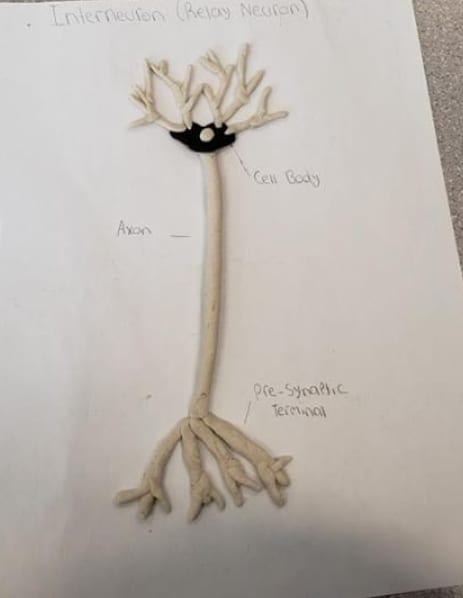Neurons are cells that transmit information. There are three different types of neuron structures, a motor neuron, sensory neuron, and interneuron. The structure of a neuron includes the cell body, which is the cells life support center. Dendrites, which conduct messages towards the cell body. The axon, which conducts messages away from the cell body. The myelin sheath covers the axon of some neurons and helps speed neural impulses. And the terminal button forms junctions with other cells. The diagrams below show the different types of neurons and their parts.



A neuron has action potential, which means it can move across the neuron fiber. A neuron has resting potential first, which means it has more positive ions outside. Inside the axon has “net” negative charge, approximately -70mv. Then it would go into depolarization which means incoming messages stimulates the section of the axon. Channels in the membrane open to allow Na+ (sodium) ions to enter the axon. The next stage is repolarization which means that channels open that allow K+ (potassium) ions to exit the axon. The charge returns to normal but causes the next segment of the axon to depolarize. The recovery phase would be next, which means sequential depolarization/repolarization causes action potential to move continuously down the axon. The visual diagram below shows this.

A synapse includes tips of terminal branches of axon, tiny spaces between neurons, ends of dendrites of receiving neuron. The axon terminal button produces neurotransmitters (NT) and stores NT in its synaptic vesicles. It also recycles NT by breaking it into smaller pieces. The action potential reaches the axon terminal and causes synaptic vesicles to release NT into the synaptic gap. The NT diffuses through the gap and binds to receptors on the receiving neuron. The NT message is received as inhibitory or excitatory. Inhibitory means it represses action potential on the receiving neuron. Excitatory means it stimulates action potential on the receiving neuron. If the receiving neuron produces action potential it’s excitatory, if it doesn’t then it’s inhibitory. The diagram below is a synapse with its parts labelled.

Photo credit to scienceblogs.com